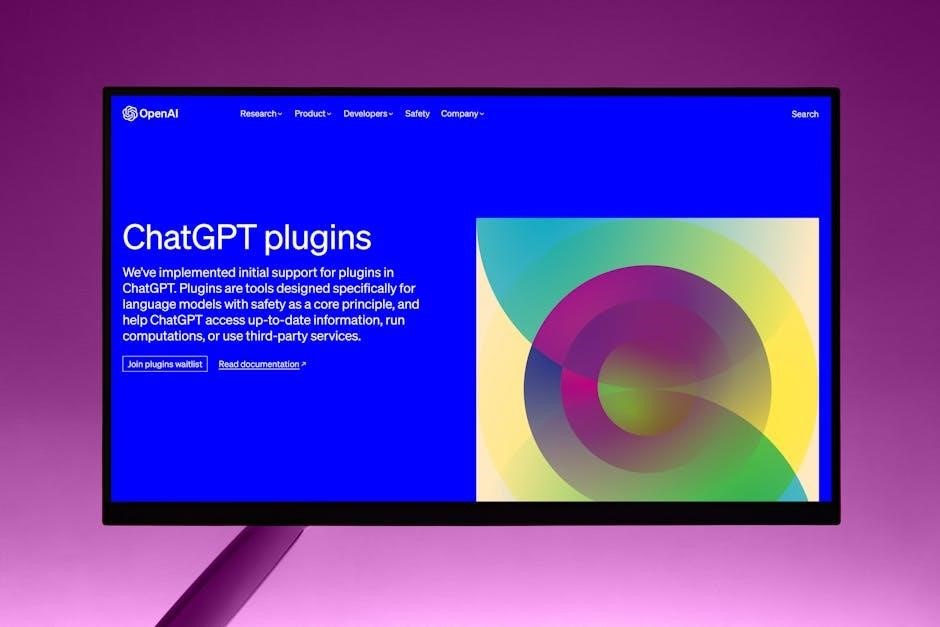PDFs are widely used for their versatility and professional presentation. ChatGPT, an AI model, assists in retrieving and analyzing PDF content efficiently, enhancing productivity and accuracy in various professional settings.
1.1 Understanding the Importance of PDF Files
PDF (Portable Document Format) files are universally recognized for their ability to maintain a fixed layout, ensuring consistency across devices. Their security features, such as encryption and password protection, make them ideal for sharing sensitive information. PDFs are widely used in professional and academic settings due to their compatibility with all operating systems. The ability to embed images, fonts, and hyperlinks enhances their versatility. Additionally, PDFs are easily searchable using specific operators like filetype:pdf in Google, making them accessible for research and information retrieval. Their popularity stems from their reliability in preserving document integrity and facilitating seamless information sharing across platforms.
1.2 What is ChatGPT and Its Role in Information Retrieval
ChatGPT, developed by OpenAI, is an advanced AI model designed to simulate human-like conversations and answer questions. It excels in processing natural language, making it a powerful tool for information retrieval. ChatGPT can assist users in crafting precise search queries, including those targeting PDF files. By leveraging its understanding of context, it helps refine searches, ensuring more relevant results. This capability is particularly useful when combined with Google’s filetype:pdf operator, enabling users to efficiently locate specific PDF documents. ChatGPT’s ability to interpret complex requests and provide structured responses enhances productivity, making it a valuable asset for researchers, professionals, and anyone seeking accurate information.

How to Search for PDF Files Using Google
Use Google’s filetype:pdf operator to find PDF files. Enter your keywords followed by filetype:pdf in the search bar to retrieve specific PDF documents efficiently.
2.1 Using the Filetype:PDF Operator in Google Search
The filetype:pdf operator in Google helps users filter search results to retrieve PDF documents specifically. By appending filetype:pdf to your search query, you can quickly locate PDF files. For example, typing “machine learning tutorial filetype:pdf” will yield PDF results on machine learning. This tool is particularly useful for accessing guides, eBooks, and academic papers. Additionally, you can refine your search by excluding specific websites using -site:example.com or use the Advanced Search feature for more precise filtering. This method ensures efficient and targeted results, making it ideal for researchers and professionals seeking specific PDF content.
2.2 Advanced Search Techniques for PDF Files
Beyond the basic filetype:pdf operator, advanced techniques refine your PDF searches. Use specific keywords or phrases in quotes for exact matches, e.g., “machine learning guide filetype:pdf.” Combine operators like site: to search within a domain or exclude unwanted sites with -site:example.com. Apply Boolean logic using AND or OR to narrow results. For instance, “artificial intelligence AND ethics filetype:pdf” yields focused outcomes. Specify languages with lang:en or filter by date using tools. These methods enhance precision, saving time by delivering highly relevant PDF documents tailored to your needs. Mastering these techniques ensures efficient and effective searches, especially for academic or professional research.
2.3 Tips for Finding Specific PDF Documents
Locating specific PDFs requires precise strategies. Start with detailed keywords, such as the document title or author. Use the filetype:pdf operator to filter results. For example, “annual report 2023 filetype:pdf” targets financial documents. Leverage site-specific searches with site:example.com to find PDFs within a particular domain. Exclude irrelevant terms using the minus sign, e.g., “sustainable energy -nuclear filetype:pdf.” Utilize Google’s advanced search tools to filter by date, language, or region. Employ quotes for exact phrases and explore related terms for broader results. Combining these techniques ensures quicker access to the desired PDFs, enhancing research efficiency and accuracy significantly. Perfecting these methods aids in retrieving specific documents effortlessly.

Integrating ChatGPT with PDF Search
ChatGPT enhances PDF search by suggesting precise terms and filters, improving query efficiency and retrieval of specific documents. It assists in refining searches and streamlining the research process.
3.1 Leveraging ChatGPT for PDF Search Queries
ChatGPT can significantly enhance your PDF search experience by suggesting precise search terms and filters. For instance, it can recommend using the filetype:pdf operator in Google to narrow down results to PDFs only. Additionally, ChatGPT can help refine your queries by proposing related keywords or phrases, improving the efficiency of your search. It can also guide you in excluding specific domains or websites, ensuring more relevant results. By leveraging ChatGPT, you can streamline your research process, save time, and quickly locate the exact PDF documents you need. This integration of AI and search functionality makes finding and accessing PDFs more straightforward and effective than ever before.
3.2 How ChatGPT Can Assist in Refining Search Results
ChatGPT is an invaluable tool for refining PDF search results by offering advanced filtering options and query optimization. It can analyze your search terms and suggest alternative phrasings or synonyms to yield more accurate results. Additionally, ChatGPT can help you apply filters such as date ranges or specific domains to narrow down your search. Its ability to understand context allows it to recommend related topics or adjustments to your search criteria, ensuring you find the most relevant PDFs. By utilizing ChatGPT, you can eliminate irrelevant results and focus on high-quality, pertinent documents, making your research process more efficient and productive.
3.3 Automating PDF Searches with ChatGPT
ChatGPT can significantly streamline PDF searches by automating the process through predefined commands and scripts. By leveraging ChatGPT’s capabilities, users can set up automated searches for specific PDF files, eliminating the need for manual input. This feature is particularly useful for repetitive searches or when monitoring updates on certain topics. ChatGPT can also generate advanced search queries using operators like filetype:pdf and combine them with other parameters to refine results. Additionally, it can automate the organization of found PDFs by categorizing them based on content or keywords. This automation not only saves time but also enhances the efficiency of retrieving and managing PDF documents, making it a powerful tool for researchers and professionals alike.

Tools and Resources for PDF Management
Discover essential tools for managing PDFs, including readers, editors, and converters. Utilize cloud services for storage and collaboration. Learn advanced search techniques using filetype:pdf for efficient document retrieval.
4.1 Best Tools for Opening and Reading PDF Files
For seamless PDF viewing, Adobe Acrobat Reader is the most popular choice, offering robust features like annotation and form filling. Foxit Reader is another excellent option, known for its lightweight design and advanced annotating tools. SumatraPDF is ideal for quick, no-frills PDF viewing, with support for multiple document formats. Google Chrome includes a built-in PDF viewer, perfect for browser-based reading. Lastly, Nitro PDF provides both viewing and basic editing capabilities. These tools ensure efficient and secure access to PDF content, catering to various user needs and preferences for enhanced productivity and convenience.
4.2 Software for Editing and Converting PDFs
For editing and converting PDF files, Adobe Acrobat Pro stands out as the industry standard, offering advanced editing, conversion, and form-creation tools. Foxit PhantomPDF is another powerful option, providing robust editing features and support for multiple formats. Nitro Pro is user-friendly, enabling seamless PDF editing and conversion with batch processing capabilities. PDF-XChange Editor is a cost-effective solution with intuitive tools for annotations and document manipulation. Additionally, LibreOffice Draw is a free alternative for basic PDF editing. Online tools like Smallpdf and Soda PDF offer browser-based solutions for quick edits and conversions, ensuring flexibility and accessibility for various user needs.
4.3 Managing PDFs in the Cloud
Cloud-based solutions simplify PDF management, offering storage, sharing, and collaboration features. Google Drive and Dropbox allow seamless PDF storage and sharing, with built-in viewers for quick access. pCloud and Box provide secure cloud storage options with robust access controls. For PDF-specific management, tools like Smallpdf and Soda PDF offer cloud-based editing, conversion, and annotation capabilities. iLovePDF is another popular choice for managing PDFs online, supporting tasks like merging and splitting documents. These platforms often integrate with AI tools like ChatGPT, enabling advanced search and automation features for enhanced productivity and organization of PDF files.

Security Considerations for PDF Files
Securing PDF files involves encryption, password protection, and safe sharing practices to prevent unauthorized access and protect sensitive data from potential breaches.
5.1 Protecting PDF Files with Passwords
Password-protecting PDFs is a reliable method to safeguard sensitive information. By using strong, unique passwords, users can prevent unauthorized access. Tools like Adobe Acrobat allow password encryption, ensuring that only those with the password can open or edit the document. Additionally, passwords can be set for printing or copying, providing an extra layer of security. Regularly updating passwords and avoiding common phrases can further enhance protection. This practice is especially crucial for sharing PDFs via email or cloud platforms, where the risk of unauthorized access is higher. Always choose complex passwords and store them securely to maintain document confidentiality.
5.2 Understanding PDF Encryption
PDF encryption is a method of securing documents by converting content into a coded format. It ensures that only authorized users with the correct password can access the data. Encryption can be applied during the creation of a PDF, typically using tools like Adobe Acrobat. There are different levels of encryption, such as AES-128 and AES-256, which provide varying degrees of security. Encrypted PDFs are particularly useful for sharing sensitive information via email or cloud platforms, as they remain protected from unauthorized access. Strong passwords and encryption ensure confidentiality, making it a critical practice for safeguarding intellectual property and complying with data protection regulations.
5.3 Safe Sharing Practices for PDF Documents
To ensure secure sharing of PDFs, always use encrypted methods. Send PDFs via encrypted email services or trusted cloud platforms like Dropbox or Google Drive. Avoid sharing sensitive documents through public Wi-Fi or unsecured networks. Use strong passwords for encrypted PDFs and share them separately through a secure channel. Verify the recipient’s identity before sending to prevent unauthorized access. Regularly update sharing permissions and revoke access if necessary. Avoid using public computers or devices to share sensitive PDFs. Consider using digital rights management tools to control document usage. By following these practices, you can protect your PDFs from unauthorized access and data breaches, ensuring confidentiality and security.

Creating and Designing PDF Files
Creating PDFs involves using tools like Adobe Acrobat or Canva. Design tips include clear layouts, readable fonts, and visual appeal. Ensure compatibility and accessibility for all users.
6.1 Best Practices for Creating PDFs
Creating professional PDFs requires attention to detail and adherence to best practices. Start with a clear structure, using headings and subheadings for easy navigation. Choose fonts that are readable across devices, such as Arial, Calibri, or Times New Roman. Ensure text is concise and well-formatted, avoiding overcrowded pages. Use high-quality images optimized for web to reduce file size without compromising quality. Include metadata like titles, authors, and keywords for better searchability. Add bookmarks for lengthy documents to enhance usability. Finally, proofread thoroughly and ensure accessibility features, such as alt text for images, are enabled. Tools like Adobe Acrobat or Canva can simplify the process.

6.2 Design Tips for Professional-Looking PDFs
Designing professional-looking PDFs involves balancing aesthetics and functionality. Start with a clean, minimalistic layout, using consistent margins and spacing. Choose a color scheme that aligns with your brand or purpose, ensuring readability. Use bold or italic fonts sparingly to emphasize key points without overwhelming the text. Incorporate high-resolution images or graphics to enhance visual appeal but avoid clutter. Ensure proper alignment and hierarchy of content, with clear headings and subheadings. Use tools like Adobe Acrobat or Canva to maintain design consistency. Finally, optimize images to reduce file size without sacrificing quality, ensuring your PDF is both visually appealing and accessible across devices.
6.3 Adding Interactive Elements to PDFs
Enhance your PDFs by incorporating interactive elements to improve user engagement. Add hyperlinks to navigate between sections or external websites, and use bookmarks for easy navigation in lengthy documents. Include fillable forms for data collection, such as surveys or applications. Embed multimedia like videos or audio files to provide additional context. Annotations and comments enable collaboration, while digital signatures streamline approval processes. Use tools like Adobe Acrobat to seamlessly integrate these features, ensuring compatibility across devices. Interactive elements not only make PDFs more dynamic but also enhance their functionality, catering to diverse user needs and expectations in professional and academic settings.

Troubleshooting Common PDF Issues
Resolve corrupted PDFs using repair tools, address compatibility issues by updating software, and fix printing problems by adjusting settings or reinstalling drivers. Ensure smooth PDF functionality across devices.
7.1 Resolving Corrupted PDF Files
Corrupted PDF files can often be repaired using specialized tools like Adobe Acrobat or online PDF repair services. These tools scan and fix damaged file structures, restoring accessibility. If a PDF won’t open, ensure it’s downloaded completely and try opening it with alternative software. Reinstalling PDF readers or updating drivers can also resolve issues; For severe corruption, use data recovery software to retrieve content. Always maintain backups and avoid downloading from unreliable sources to prevent corruption. Using ChatGPT, users can find step-by-step guides and recommendations for the best repair tools, streamlining the recovery process and minimizing data loss.
7.2 Fixing Compatibility Issues with PDFs
Compatibility issues with PDFs often arise when viewing them across different software or devices. To fix this, ensure your PDF reader is updated, as outdated versions may not support newer PDF formats. Use universal readers like Adobe Acrobat or web-based tools for consistent viewing. If a PDF created with specific software doesn’t open elsewhere, try converting it to a standard PDF format using online converters. ChatGPT can recommend reliable tools for conversion and provide troubleshooting guides. Additionally, check for updates in your PDF software and avoid using non-standard PDF creators. Regularly updating your software ensures compatibility and smooth functionality across platforms.

7.3 Troubleshooting PDF Printing Problems
Printing issues with PDFs often stem from outdated drivers or incorrect settings. Ensure your printer drivers are up-to-date and compatible with your PDF software. Use the “Save As” option to create a new PDF, which can resolve formatting issues. Check printer settings to ensure the correct paper size and orientation are selected. If problems persist, use ChatGPT to find specific solutions tailored to your software or printer model. Additionally, consider using web-based PDF tools to bypass local printing issues. Regularly updating your PDF reader and printer drivers helps prevent such problems. Always test print a page to confirm settings before final printing.

The Future of PDF Files and ChatGPT Integration
The future of PDFs lies in AI-driven enhancements, with ChatGPT enabling smarter searches and content manipulation. Expect seamless integration, advanced editing, and AI-powered insights, revolutionizing document workflows and collaboration.
8.1 Emerging Trends in PDF Technology
PDF technology is evolving rapidly, with advancements in AI integration, enhanced security features, and improved usability. ChatGPT is playing a pivotal role in enhancing PDF accessibility, enabling smarter searches and content extraction. The rise of cloud-native PDF solutions is another significant trend, allowing seamless collaboration and real-time editing. Additionally, interactive PDFs with embedded multimedia and dynamic forms are gaining popularity, making documents more engaging and functional. These innovations are reshaping how PDFs are created, shared, and utilized, ensuring they remain a cornerstone of digital communication in an increasingly connected world.
8.2 Enhancing PDF Search with AI
AI technologies like ChatGPT are revolutionizing PDF search by enabling smarter and more efficient document retrieval. Advanced algorithms analyze content, metadata, and context to deliver precise results. Natural language processing allows users to query PDFs using conversational phrases, making searches more intuitive. AI-powered tools can also extract specific data, summarize content, and even translate text within PDFs. These capabilities significantly enhance productivity, especially for researchers and professionals handling large volumes of documents. By integrating AI with PDF search, users gain faster access to relevant information, streamlining workflows and improving decision-making processes across industries.
8.3 The Role of ChatGPT in the Evolution of PDF Management
ChatGPT is transforming PDF management by offering intelligent search, content extraction, and document analysis. Its ability to understand natural language enables users to locate specific PDFs quickly and efficiently. ChatGPT can summarize long documents, extract key information, and even assist in translating or editing PDF content. These features enhance productivity and accessibility, making PDF management more streamlined. As AI advancements continue, ChatGPT is poised to play a pivotal role in revolutionizing how PDFs are handled, offering innovative solutions for professionals and researchers alike. This integration of AI with PDF management tools promises to simplify workflows and improve overall efficiency in handling digital documents.
PDF files and ChatGPT together enhance document management and information retrieval, offering efficient solutions for professionals and researchers, improving productivity and streamlining workflows effectively.
9.1 Summary of Key Points
9.2 Final Thoughts on Filetype:PDF and ChatGPT
The integration of filetype:PDF searches with ChatGPT represents a significant advancement in document management and retrieval. PDFs, with their universal compatibility and security features, remain indispensable for professional and personal use. ChatGPT’s ability to refine searches, automate tasks, and provide insights enhances user efficiency. As AI continues to evolve, the synergy between PDFs and ChatGPT will likely deepen, offering even more innovative solutions. This combination empowers users to manage and retrieve information seamlessly, making it a transformative tool for modern workflows. The future of PDFs and ChatGPT integration holds immense potential, further solidifying their roles as essential technologies in our digital landscape.
